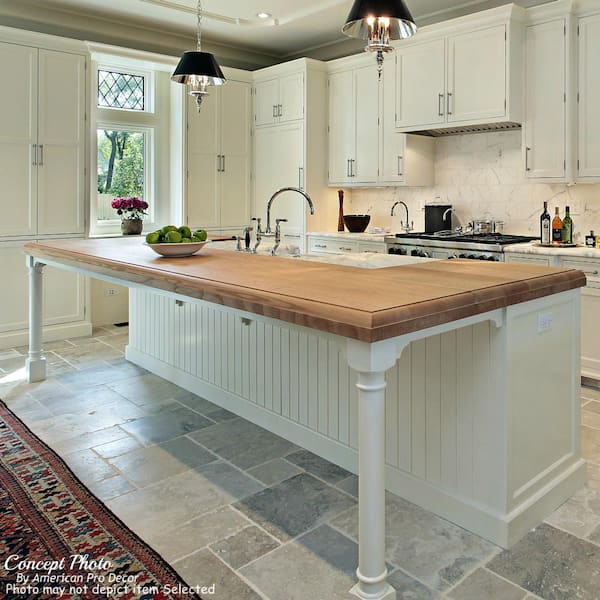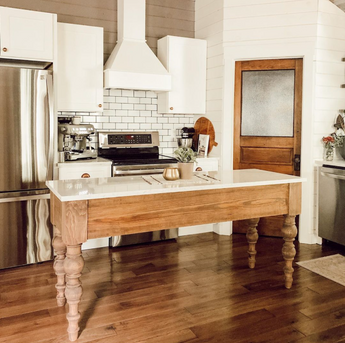How to Integrate a Kitchen Island Leg right into Your Kitchen Remodel
How to Integrate a Kitchen Island Leg right into Your Kitchen Remodel
Blog Article
The Significance of a Sturdy Cooking Area Island Leg in Producing a Functional Cooking Area
A tough kitchen island leg serves as a basic component in establishing a functional food preparation atmosphere, supplying needed assistance for both the countertop and various kitchen tasks. As kitchen areas evolve into multifunctional areas for cooking, dining, and interacting socially, the selection of products and design factors to consider for island legs comes to be progressively crucial.
Advantages of Sturdy Island Legs
Offering important support, sturdy kitchen island legs play a crucial role in improving the functionality and durability of kitchen islands - kitchen island leg. These legs not only bear the weight of the countertop and any kind of additional things positioned on the island, yet also add to the general stability of the framework. A well-supported cooking area island makes certain that it remains upright and useful, also under heavy usage, which is especially essential in busy kitchen environments
Additionally, sturdy island legs can boost the aesthetic allure of the kitchen. They provide a strong framework that can match numerous style styles, from modern to standard. This convenience enables home owners to customize their kitchen islands according to individual taste while making sure that the structural integrity continues to be uncompromised.
In enhancement to their encouraging role, robust kitchen area island legs can likewise enhance safety and security. Eventually, investing in sturdy kitchen island legs is essential for a practical and aesthetically pleasing cooking location.
Products for Cooking Area Island Legs
When selecting materials for kitchen area island legs, sturdiness and aesthetic appeal are essential aspects to take into consideration,. One of the most common materials include wood, metal, and crafted timber, each offering one-of-a-kind advantages.
Wood, such as oak, maple, or cherry, is a traditional option as a result of its stamina and classic beauty (kitchen island leg). It can endure substantial weight and is immune to put on, making it perfect for high-use cooking area environments. Additionally, hardwood can be discolored or painted to match various kitchen styles
Metal legs, commonly crafted from stainless-steel or functioned iron, supply a modern and industrial look. They are unbelievably solid and can sustain significant lots while being resistant to dampness and warm, which is advantageous in a cooking area. Metal legs can additionally be quickly cleansed, enhancing their usefulness.

Design Factors To Consider for Stability
The choice of products for cooking area island legs straight affects the design factors to consider for security. When making a kitchen area island, it is paramount to assess the weight-bearing capacity of the chosen products. Much heavier products, such as strong timber or metal, typically supply greater stability, especially under the anxiety of day-to-day use.
In addition, the leg style must integrate proper geometry to boost security. A larger base raises the support location, minimizing the threat of tipping or tottering. Factor to consider needs great site to also be provided to the height of the legs; out of proportion leg lengths can result in discrepancy, compromising the total security of the island.
Moreover, the circulation of weight throughout the island is vital. Guaranteeing that the leg placement aligns with the heaviest components, such as home appliances and countertops, will further boost stability.
Maintenance Tips for Longevity

Depending on the material of the legs-- whether wood, metal, or composite-- ideal cleaning techniques must be used. Steel legs may need a light gloss to avoid corrosion and preserve their radiance.
In addition, tightening bolts and screws on a regular basis can make sure stability and stop wobbling. Consider reinforcing the legs with extra braces or sustains to improve sturdiness if the cooking area island experiences hefty usage. Lastly, applying a safety coating or sealer can safeguard against dampness and stains, prolonging the life-span of the legs. By adhering to these maintenance tips, house owners can guarantee their kitchen area island legs continue to be robust look at this website and useful for several years ahead.
Selecting the Right Leg Style
Regular maintenance makes sure that kitchen area island legs continue to be functional and sturdy, but selecting the appropriate leg design is just as crucial for both visual appeals and support. The selection of leg Continue style can significantly affect the total style and harmony of your cooking area.

Functionality is another important element. Thicker legs or those with a tough base can sustain much heavier counter tops and devices, improving the island's utility. On the other hand, slim legs might produce a ventilated appearance, suitable for lighter designs but potentially much less helpful.
Final Thought
In summary, the importance of sturdy cooking area island legs can not be overemphasized in the production of a functional cooking location. These legs supply essential support, improve stability, and add to the total visual of the kitchen.
A tough cooking area island leg serves as a fundamental part in developing a practical food preparation atmosphere, offering required assistance for both the counter top and various kitchen activities.Offering essential support, strong kitchen island legs play an essential duty in improving the capability and longevity of cooking area islands. Eventually, investing in tough kitchen area island legs is vital for a functional and visually pleasing cooking location.
Consideration ought to also be provided to the elevation of the legs; disproportionate leg lengths can lead to inequality, jeopardizing the overall security of the island.
Wood legs offer warmth and a traditional appearance, while steel legs supply a industrial and modern-day feel.
Report this page